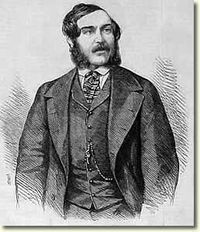Annotation:Off to Charleston Quadrille: Difference between revisions
m Text replacement - "garamond, serif" to "sans-serif" |
No edit summary |
||
| Line 1: | Line 1: | ||
---------- | |||
---- | {{TuneAnnotation | ||
|f_tune_annotation_title= https://tunearch.org/wiki/Annotation:Off_to_Charleston_Quadrille > | |||
'''OFF TO CHARLESTOWN QUADRILLE.''' English, Quardrille. England, Dorset. The quadrille was an arrangement of existing melodies from the British Isles and America set by the popular mid-Victorian composer Charles D'Albert (1809-1886), who was born in Hamburg, Germany, to a captain of cavalry in the French army. When his father died in 1816, the 7-year-old Charles and his mother emigrated to England, where he was resident for most of his life. | |f_annotation='''OFF TO CHARLESTOWN QUADRILLE.''' English, Quardrille. England, Dorset. The quadrille was an arrangement of existing melodies from the British Isles and America set by the popular mid-Victorian composer Charles D'Albert (1809-1886), who was born in Hamburg, Germany, to a captain of cavalry in the French army. When his father died in 1816, the 7-year-old Charles and his mother emigrated to England, where he was resident for most of his life. | ||
[[File:dalbert.jpg|200px|thumb|left|Charles D'Albert]] | [[File:dalbert.jpg|200px|thumb|left|Charles D'Albert]] | ||
"The Quadrille was a popular 19th Century square dance, with five figures which retained their names even when different music was used for the dance. '''Groves''' gives the names of the figures as: ''La pantalon'', ''L'ete'', ''La poule'', ''La pastourelle'' (often replaced by La Trenis as here) and ''Finale''. The musical selections would have been designed for trained rather than traditional musicians, and frequently use a higher range than would be comfortable for the average fiddler--in the MS there are passages written in parallel octaves (e.g. the Finale of this selection) where only the lower octave is given here" (Trim). | "The Quadrille was a popular 19th Century square dance, with five figures which retained their names even when different music was used for the dance. '''Groves''' gives the names of the figures as: ''La pantalon'', ''L'ete'', ''La poule'', ''La pastourelle'' (often replaced by La Trenis as here) and ''Finale''. The musical selections would have been designed for trained rather than traditional musicians, and frequently use a higher range than would be comfortable for the average fiddler--in the MS there are passages written in parallel octaves (e.g. the Finale of this selection) where only the lower octave is given here" (Trim). | ||
| Line 22: | Line 22: | ||
Previous issue Wednesday 10 October 1860 | Previous issue Wednesday 10 October 1860 | ||
|f_source_for_notated_version= | |||
|f_printed_sources= Trim ('''The Musical Legacy of Thomas Hardy'''), 1990; No. 74. | |||
|f_recorded_sources= | |||
|f_see_also_listing= | |||
}} | |||
Latest revision as of 16:02, 19 June 2024
X:0 T: No Score C: The Traditional Tune Archive M: K: x
OFF TO CHARLESTOWN QUADRILLE. English, Quardrille. England, Dorset. The quadrille was an arrangement of existing melodies from the British Isles and America set by the popular mid-Victorian composer Charles D'Albert (1809-1886), who was born in Hamburg, Germany, to a captain of cavalry in the French army. When his father died in 1816, the 7-year-old Charles and his mother emigrated to England, where he was resident for most of his life.

"The Quadrille was a popular 19th Century square dance, with five figures which retained their names even when different music was used for the dance. Groves gives the names of the figures as: La pantalon, L'ete, La poule, La pastourelle (often replaced by La Trenis as here) and Finale. The musical selections would have been designed for trained rather than traditional musicians, and frequently use a higher range than would be comfortable for the average fiddler--in the MS there are passages written in parallel octaves (e.g. the Finale of this selection) where only the lower octave is given here" (Trim).
The five dance figures of "Off to Charleston Quadrille" are:
Figure 1) "Limerick Races" (Pantalon)- 6/8 time, F Major, AB.
"Johnny Sands" - 6/8 time, B Flat Major, One part
Figure 2) "Irish Emigrant (The)" (L'Ete)- 2/4 time, C Major, ABABA.
Figure 3) "Twas on a Sunday Morning" (La Poule)- 6/8 time, G Major, AB.
Sally Come Up - 6/8 time, C Major, C.
Figure 4) "I'm Leaving Thee in Sorrow Annie" (Trenise {La Trenis}) - 2/4 time, C Major, ABABA.
Figure 5) "I'm Off to Charlestown" (Finale)- 2/4 time, F Major, ABA.
The "Off to Charleston Quadrille" was mentioned in the May 17th, 1860, edition of the Shields Daily Gazette, Tyne and Wear, England, as being on the program of a military band's evening event. It was also mentioned in the South Australian Register of October 10th, 1860, in an advertisement of sheet music "newly arrived at Hilliers" (store), 10 Hindley Street, Adelaide.
(about)
Previous issue Wednesday 10 October 1860

